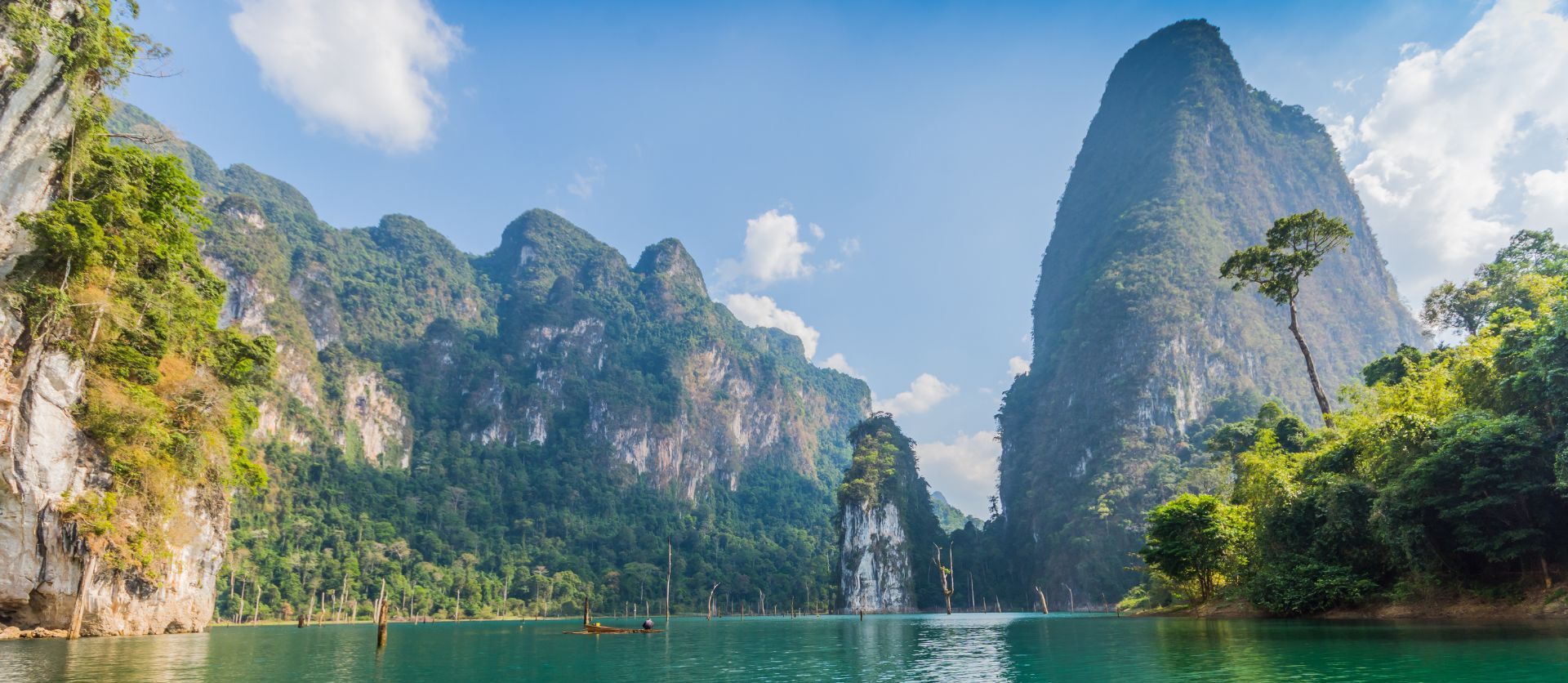
Thailand
Thailand is one of Asia’s most popular destinations, known for its tropical beaches, ornate temples, vibrant street food, and warm hospitality. From the bustling streets of Bangkok to the cultural charm of Chiang Mai and the stunning islands of Phuket and Krabi, a Thailand itinerary offers something for every kind of traveller. Visitors come for island-hopping, wellness retreats, adventure sports, and traditional Thai cuisine, while others seek out its rich history at Ayutthaya and Sukhothai UNESCO sites. Whether you’re planning a Thailand honeymoon, family trip, or solo backpacking journey, the country’s diversity makes it one of the best places to visit in Southeast Asia.
Top Things to Do in Thailand
Staying afloat
Founded in the 18th century by Muslim fishermen from Indonesia, this floating village was established for its abundant fishing grounds and natural storm shelter. Today, around 1,500 residents inhabit colorful houses built on stilts over the emerald waters of Phang Nga Bay. While many original settlers were Indonesian fishermen, the community has welcomed Thai and foreign families, creating a multicultural environment. This blend enriches the traditions, cuisine, and festivals, making the village a dynamic example of resilience and cultural fusion.
Are you ready to explore the harmonious lifestyle of this extraordinary community and experience its breathtaking scenery?
Best time to visit: November to March
Of Dancers and Dancing Lanterns
Amidst the glow of thousands of floating lanterns, the Fon Phae dance springs to life, intertwining the celebration of rural traditions with the magic of illumination. This vibrant performance, traditionally showcased during festive occasions, depicts the rhythms of nature through activities like rice planting and harvesting, reflecting the community’s deep connection to the land.
Dancers wear colourful, handwoven costumes adorned with intricate patterns, bringing their cultural heritage to life. With graceful movements and expressive hand gestures, they resonate with the audience, conveying stories of hope and prosperity. In this enchanting setting, the Fon Phae dance becomes a mesmerizing tribute to tradition and the beauty of light.
Are you prepared to create unforgettable memories under the shimmering lights?
Best time to visit: November
The Monk, The Blessing, and Thailand
Buddhism was introduced to Thailand over 2,500 years ago, flourishing and evolving into a rich spiritual heritage that now thrives in more than 40,000 monasteries across the country. This profound faith emphasizes the importance of harmony, mindfulness, and the quest for inner peace.
Your journey in Thailand is incomplete without experiencing a monk blessing ceremony, a beautiful rite to embark on new beginnings. Feel a sense of bliss as you participate, presenting offerings of fragrant flowers, rice, and incense sticks, immersing yourself in a vibrant tapestry of tradition and spirituality.
Embrace the opportunity to connect with this sacred practice and invite the blessings that await!
Best time to Visit: All year-round
The Tale of Hidden Treasure
When this royal kingdom fell in 1767, a gold Buddha statue was hidden by locals to protect it
from invading forces. Covered in plaster, the statue remained concealed for centuries. It
wasn’t until a restoration project in Bangkok that the plaster cracked, revealing the statue’s
golden core, which had been kept secret for generations.
Get set to discover the secrets and the air of mystery surrounding this ancient kingdom close
to Bangkok.
Best time to Visit: November to February
Legend of the Jungle Spirits
This National Park is said to be home to spirits of the jungle, believed by locals to guard the dense rainforest and its secrets. One popular tale speaks of a mysterious river that runs through the park, where an ancient spirit named Mae Thorani, the goddess of water, watches over the waters to protect the land from harm. She is said to emerge during storms, her figure shimmering through the mist, warning intruders to leave.
Traverse the hidden world of myths and nature on this off-the-beaten-path experience like no other.
Best time to Visit: November to April
Thailand Travel by Season
In Thailand, the seasons are defined by a tropical climate that transitions through distinct phases, each bringing its own charm and allure. The rich culture and diverse geography of the country create unique experiences that vary with the seasons. Whether it’s the vibrant festivals of the dry season or the lush landscapes of the rainy season, Thailand offers something captivating year-round, ensuring an unforgettable journey at any time.

Rabi Rutu / Cool Season
November to February
As the temperatures cool down, this season is marked by pleasant weather and vibrant festivals. It’s the perfect time to explore bustling markets and enjoy outdoor activities amidst stunning natural beauty.
Recommended Destinations:
Chiang Mai, Bangkok, and Ayutthaya

Gris Rutu / Summer
March to May
The heat intensifies as the summer approaches, making this a vibrant time filled with celebrations like Songkran, the Thai New Year. It’s ideal for enjoying the beach and water activities.
Recommended Destinations:
Phuket, Krabi, & Pattaya

Burin Rutu / Rainy Season
June & October
The monsoon rains rejuvenate the landscape, turning it lush and green. This season offers a quieter experience, perfect for exploring temples and enjoying the natural beauty without the crowds.
Recommended Destinations:
Khao Sok National Park, Pai, & Koh Samui
Thailand Travel: FAQs
What is the best time to visit Thailand for travellers?
The best time to visit Thailand is from November to March, when the weather is cooler and ideal for sightseeing, island-hopping, and outdoor activities. April to June is hot but less crowded, while July to October is monsoon season with occasional heavy rains but also lush landscapes and fewer tourists.
How many days are enough for a trip in Thailand?
A well-planned Thailand itinerary usually needs at least 7–10 days to cover the highlights. With a week, travellers can explore Bangkok, Chiang Mai, and a beach destination like Phuket or Krabi. For a deeper experience, 12–14 days allow time for cultural sites like Ayutthaya and Sukhothai, plus island-hopping in the south. Shorter trips of 4–5 days are possible, but focusing on one region is best. AEJ offers curated Thailand itineraries designed around trip length and traveller preferences.
What kind of traveller is Thailand ideal for?
Thailand is perfect for almost every type of traveller — honeymooners looking for luxury resorts, families seeking cultural experiences, backpackers exploring hostels and street food, and adventure seekers trying scuba diving, trekking, or rock climbing. Wellness travellers also flock here for yoga retreats and traditional Thai massages.
What is Thailand famous for?
Thailand is famous for its tropical beaches, ornate temples, floating markets, vibrant nightlife, and Thai cuisine. Highlights include Bangkok’s Grand Palace, Phuket’s beaches, Chiang Mai’s temples, Ayutthaya’s ruins, and Krabi’s limestone cliffs. Wellness retreats, Thai massages, and island-hopping tours make it one of the most sought-after destinations in Southeast Asia.
Do Indian travellers need a visa to visit Thailand?
No, Indian travellers do not need a visa for short tourist visits. Under the current policy, Indians can enjoy a 60-day visa-free stay, with a possible extension at the immigration office. Starting May 2025, all visitors—including Indian travellers—must complete the Thailand Digital Arrival Card (TDAC) within 3 days before arriving. The form is free and mandatory for entry. Travellers can fill it out on the official portal: Thailand Digital Arrival Card.
What currency is used in Thailand, and can travellers use credit cards?
The currency in Thailand is the Thai Baht (THB). Credit and debit cards are widely accepted in cities, hotels, and restaurants, but cash is preferred in markets, street stalls, and rural areas. ATMs are easily available across the country, and currency exchange counters offer competitive rates.
What language is spoken in Thailand?
The official language is Thai, though English is widely understood in major tourist areas like Bangkok, Phuket, and Chiang Mai. In smaller towns, basic phrases or translation apps can be useful for smoother communication.
What local etiquette should travellers follow in Thailand?
Thai culture places strong emphasis on respect. Always greet with a wai (palms together), avoid touching people’s heads, and dress modestly when visiting temples. Shoes must be removed before entering homes and religious sites. Public displays of anger are frowned upon, and it’s considered disrespectful to point your feet at others or at Buddha images.
What should travellers know about Thai food and dietary options?
Thai cuisine is world-famous for its flavours — from pad thai and green curry to street food like mango sticky rice. Vegetarian and vegan options are available, though travellers should clarify as fish sauce is commonly used. Halal food can be found in many areas, especially in southern Thailand.
Is Thailand budget-friendly, and how much should travellers budget per day?
Thailand is one of the most budget-friendly destinations in Asia. Backpackers can manage on INR 3,000–5,000 per day, mid-range travellers should budget INR 6,000–9,000, and luxury travellers may spend INR 12,000+ daily on resorts, fine dining, and private tours.
What are the main airports in Thailand for international travellers?
The busiest airports are Suvarnabhumi Airport (Bangkok), Don Mueang Airport (Bangkok), Phuket International Airport, and Chiang Mai International Airport. These hubs connect Thailand with major international cities and domestic destinations.
How easy is it to travel around Thailand?
Thailand has a reliable network of domestic flights, trains, buses, and ferries. Low-cost airlines like AirAsia and Nok Air make island-hopping convenient. Overnight trains connect Bangkok to Chiang Mai and other cities, while tuk-tuks and songthaews (shared taxis) are popular for local travel.
What is train travel in Thailand like for tourists?
Train travel in Thailand is scenic and affordable, with routes connecting Bangkok to Chiang Mai, Ayutthaya, and Hua Hin. Classes range from basic third-class seats to air-conditioned sleepers. Trains are slower than flights but offer an authentic way to see the countryside. Tickets can be booked at stations, online, or through agencies, but availability can be limited during peak season.
Is it safe and legal for foreigners to drive or rent cars/2-wheelers in Thailand?
Yes, foreigners can rent and drive cars in Thailand with a valid International Driving Permit (IDP). Roads are generally good, but traffic in Bangkok can be chaotic. Motorbike rentals are popular in islands and smaller towns, though safety precautions and insurance are essential.
What is the connectivity like between major cities in Thailand?
Connectivity between Thailand’s major cities is excellent by domestic flights, trains, and buses. Budget airlines make routes like Bangkok–Chiang Mai or Bangkok–Phuket quick and affordable, while overnight trains are a scenic way to reach Chiang Mai or Surat Thani. Buses and minivans run frequently between popular destinations, and ferries connect the islands to the mainland. With multiple options available, travelling across Thailand is convenient for every budget and style of trip.
Discover our carefully curated selection of itineraries to indulge your happy feet. Embark on a journey of discovery in the most intimate setting tailored to your travel needs.
Inspired by what you see? Connect with us to design a meticulously curated journey with our travel ARTHitect — the journey of your dreams is just a conversation away.
